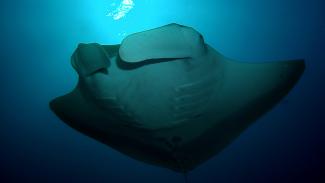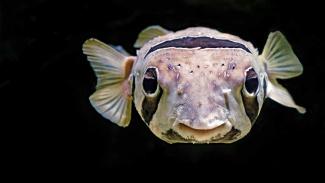Batfish - Ephippidae
Batfish are a small family of seven genera the only one found in shallow water is Platax, five species of large round silvery fish.
They are a favourite with divers because of their curious nature, individuals regularly approach divers closely even following them.
They are either solitary, in pairs or a group, sometimes seen in special friendship with a turtle. Juveniles are often boomerang shaped and some species have elaborate markings to mimic something else.

Family variety
Behaviour
Some Batfish swim on their sides in strong current while others are known to turtles. Juveniles are often shy, sheltering under overhangs and in caves.
Reproduction
Diet
Defences
FACTFILE
SPECIES: 5
SIZE RANGE: 35-65 cm
DISTRIBUTION:
Platax Batfish are found in all Asian tropical seas.
HABITAT:
On or near coral reefs in pairs or small groups. Juveniles can be seen sheltering in the reef.
THREATS:
Fished heavily. Prized for sport fishing. Juveniles threatened by aquarium trade.
Identification tips
-
Rounded body with high dorsal and anal fins that get smaller with age in many species. Combination of round body and tall fins give the overall spade shape of these fish.
-
Short tail fin.
-
Silvery body with black and sometimes yellow markings.
-
Juvenile often boomerang shaped mimic leaves, sea grass, flatworms or crinoids.
Popular species
Look out for these species of Batfish on your next scuba dive!
Tall-fin Batfish
(Platax teira)

One of the most commonly seen Batfish by divers, identified by its steep head profile and the large black blotch by the ventral fin. Juveniles have extremely tall dorsal and anal fins and vertical black bands that usually fade with age.
Round Batfish
(Platax obicularis)

Large round Batfish with two vertical black bars on their heads. Distinguished from other species by small black speckles on their sides. Juveniles mimic dead leaves floating in the current until they are well into their juvenile stage, seeking out shallow beaches or lagoons when they finally settle.
Shaded Batfish
(Platax pinnatus)

Much more solitary than any of the other species and very rarely seen in groups. They are more shy than other species and more likely to swim away from divers. They can be identified by their distinctive protruding snout. Juveniles are spectacular - all black with a perfect orange ring around the edge of their fins. They mimic poisonous flatworms to discourage perspective predators.







